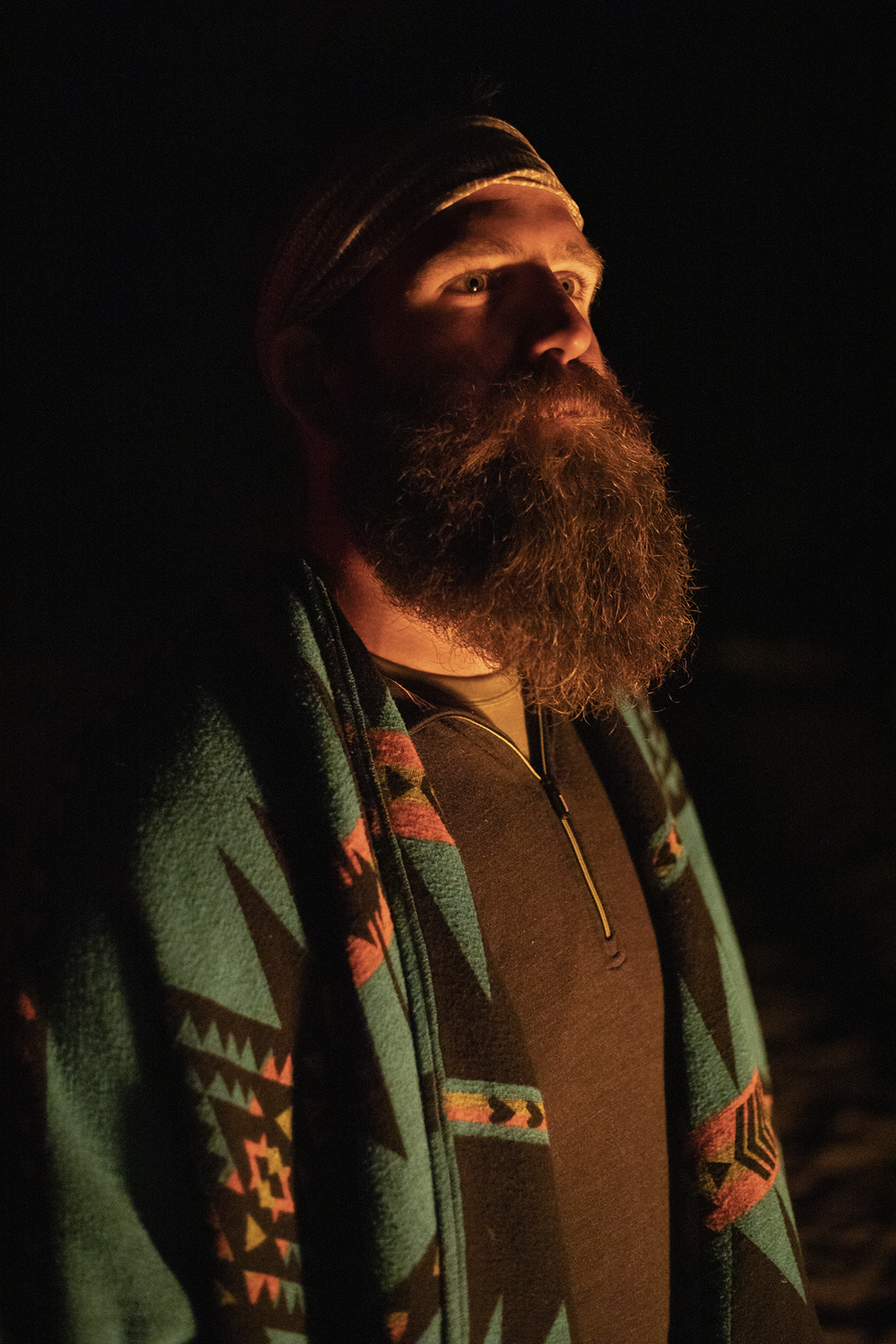E WERE 24 HOURS into our four-day rafting trip deep within the canyons of Colorado when our wild-eyed leader, Joe Hawley—best known as the impressively bearded former center of the Atlanta Falcons and Tampa Bay Buccaneers—told us to park our rafts, make camp, and prepare to head into the mountains.
Hawley, 33, sported a jade pendant necklace that complemented his turquoise camping gear. All day, he’d been sharing vague spiritual maxims like “What I’ve found is that all of it comes back to presence. The key thing is to be present with everything that comes up.” Then he got specific: “We’re going to be hiking up to a beautiful waterfall and then dropping into a workshop that will help us confront our deepest fears.”
Two hours later, five strangers—all hulking ex–NFL linemen—and I had ascended rocky terrain to reach a ledge about 500 feet above the river, which glistened below like tempered glass. We were sweaty and tired, but Hawley, who is 60 pounds lighter than in his playing days, appeared more energized. He took off his boots and stood barefoot to introduce Ben Harris, a blond and deeply tan “fear alchemist” and podcaster, who had tagged along to lead this workshop.
We’d all been issued journals, so Harris gave us a writing prompt: If fear didn’t exist, what would you do?
Hawley seemed to be already living his answer. “I got this insight to start a community for former athletes, but it scared the shit out of me,” he’d told us earlier. “I always have played kind of small as a leader. One of my biggest fears was being seen and stepping up and having the limelight on me.”
Advertisement – Continue Reading Below

Joe Hawley left the NFL at 29 feeling physically, mentally, and spiritually broken. He wants to help more men like him.KYLE SAFIEH
In 2018, at 29, Hawley exited the NFL, having earned an estimated $13 million over eight grueling seasons. All it cost him was his body (a reconstructed knee, torn shoulder cartilage, bone spurs, and a bulging disk) and any real identity beyond the game. So he set out to find himself and explore the country in a van with just his dog. Today he describes that two-year odyssey as his “healing path,” which led him to form the Härt Collective, an exclusive men’s community that he started in 2020 to help former pro athletes become more “emotionally intelligent [and] self-aware” through “heart-centered work.”
Advertisement – Continue Reading Below
As a former Olympic fencer, I’d lived my own version of his story. After winning a silver medal at the Beijing Games in 2008, I ended my career with all-time-high levels of anxiety from consistently hiding my problems, hoping to compensate through my will to succeed. Even after extensive therapy, I still struggle, because my perfectionism often leads to periods of emotional withdrawal. So when I heard about the Collective and its focus on rehabilitating that hypermasculine, win-at-all-costs mentality, I asked to join one of the trips.
Currently, a total of ten members (all ex-NFLers, plus one former NHL player) pay $99 per month for weekly check-in calls with Hawley and exclusive dispatches from a rotating cast of ex-athletes, spirituality influencers, and mental-health experts. They also get access to discounted retreats like this one, which was billed as an off-grid self-help gauntlet that cost $2,200 and would take us through northwest Colorado into Utah along the Green River, a 44-mile stretch of water with about a half dozen class III and IV rapids.
“You say the word vulnerability and automatically walls come up,” Hawley told me. “The Trojan-horse idea was creating these retreats around experiences like whitewater rafting.” Along the way, we’d participate in workshops focused on what seemed to be four emotional pillars of the male psyche: brotherhood, fear, anger, and shame.
Advertisement – Continue Reading Below

Of course, journaling about what you’d do if fear didn’t exist is an exercise we might all benefit from—even if you don’t want to reveal the results. But after ten minutes of writing time, Harris reminded us that we could find commonality in our most fundamental fears and invited us to share. For a long moment, the men looked everywhere except at one another. Nobody volunteered.

THE FEAR EXERCISE was supposed to explore the second of our four emotional pillars, but judging by the hesitation among the group, it was clear our earlier attempts at brotherhood hadn’t fully paid off. The day before, in a dirt pasture full of balsamic-scented cottonwoods, we’d paired off to stare into a partner’s eyes for five long minutes. Then Hawley told us to say “I love you” to each other.
Advertisement – Continue Reading Below
My partner, Garrett Reynolds, 34, a six-foot-seven, 290-pound ex-Ram with a blond man bun and beard, had gone first.
“I love you . . . man,” he said with a thick Tennessee twang.
I said, “I love you” back but not without some effort.
Later, another former player explained why Reynolds’s slight improvisation might have been important: “I love you, man, but I’m not gay,” he said, causing the whole group to laugh hard—me included.
The moment was funny but made me feel a bit uneasy. More than a decade ago, I’d chuckled at hundreds of similar locker-room jokes while wearing a plastered smile to hide my discomfort with a culture that awards status to those who egg each other on. I worried about fitting in with seemingly powerful and confident men.
When Harris invited us to share our fears at the top of the cliff, I saw it as my chance to be a team player and volunteered to go first. Harris walked me through a logic exercise that reminded me of my time spent at Tony Robbins seminars. First, I read what I’d written: I would be more openly affectionate toward my wife. He asked what stood in my way. I shared with the group the same thing I’d shared at many men’s groups before this: For years, I’d struggled to perform in bed because I was so worried about disappointing my partner—and that had probably created a strong fear of failure.


